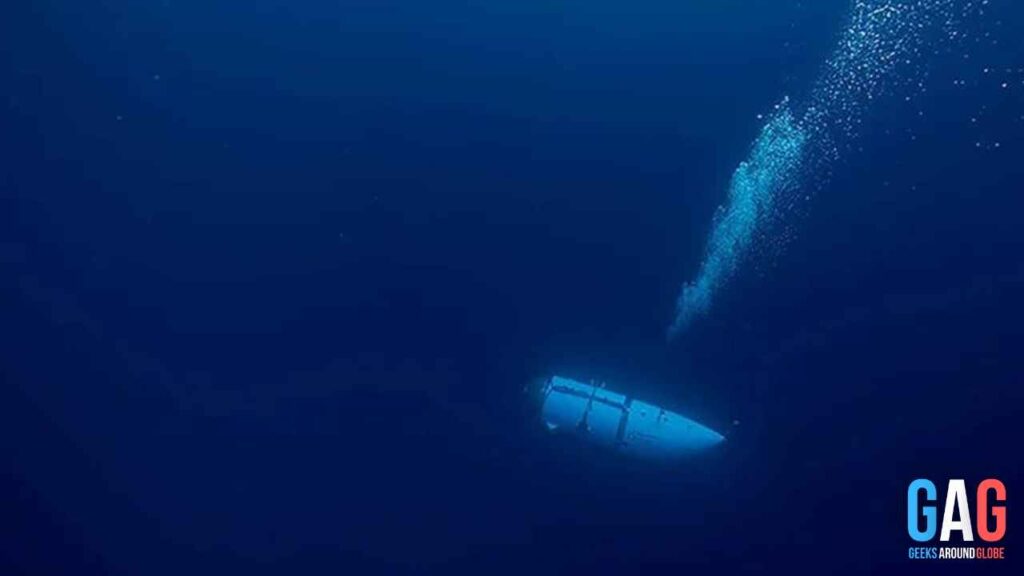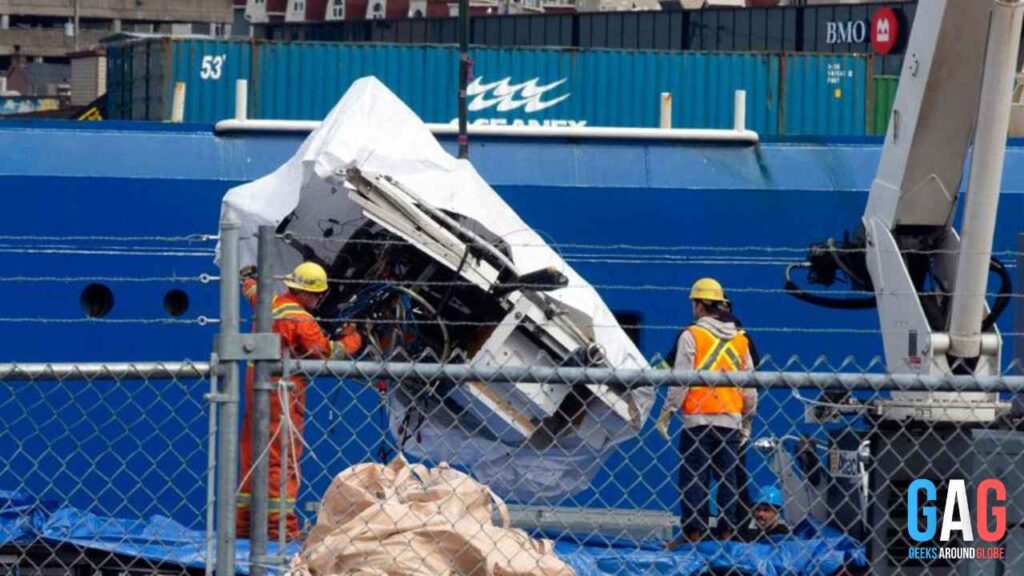A tragic event unfolded when the TITAN submarine experienced a catastrophic implosion during its descent into the Titanic shipwreck. Understanding the consequences of such an event raises questions about what happens to a person when a submarine implodes. In this article, we will discuss the effects of an implosion on those inside the vessel.
What Happens to a Person When a Submarine Implodes:
When a submarine implodes, enormous water pressure causes the hull to suddenly collapse. In the case of the TITAN, debris found 1,600 feet from the bow of the Titanic confirmed that the vessel likely suffered an implosion, as mentioned in a report by Insider. The pressure at extreme depths is so immense. For those inside an imploding submarine, the experience could cause instant fatality.
One aspect to consider while examining this tragic event is the speed at which the implosion occurs. According to submarine expert Eric Fusil, it would take only 20 milliseconds to crush a hull at such depths, as noted in an article from Metro. The rapid nature of an implosion makes any chance of survival almost nonexistent for the individuals inside.
You might also be interested in : How One Captains Ignorance Led the TITAN Implosion

The Science Behind Submarine Implosions
Pressure Differences
At extreme depths, the hydrostatic pressure of the surrounding water becomes immense. This is significantly higher than the atmospheric pressure that exists within a submarine. When the pressure difference becomes too great to bear, a submersible vehicle like Titan can implode.
A catastrophic implosion occurs when the external pressure exceeds the strength of the vessel’s hull. This resulted in the structure rapidly collapsing inwards. The immense force of this collapse causes a sudden release of energy. In the case of the Titan submarine, the occupants would have died instantly due to the rapid and violent event.
Structural Weaknesses
As a submarine dives deeper, the increased water pressure puts a strain on the vessel’s hull, causing it to gradually deform. Sometimes, existing structural weaknesses can exacerbate this effect. If the hull is unable to withstand the pressure, the metal may begin to buckle and collapse, leading to an implosion.
The implosion of a submersible like the Titan can be attributed to a combination of factors, including pressure differences and structural weaknesses in the hull. When these elements converge, the outcome is a catastrophic event that has the potential to instantly claim the lives of those on board, as was the case for the passengers of the Titan submarine.
Implications of Submarine Implosions
Physical Effects on a Person
When a submarine implodes, the external pressure surpasses the submarine’s structural integrity, resulting in a sudden collapse. This extreme event has several significant physical consequences on anyone inside the submarine. The imploding forces are so immense that they can instantaneously compress and crush the human body beyond recognition. The extreme water pressure would inflict severe damage to the internal organs and skeleton.
Furthermore, the collapse produces a massive shockwave that propagates through the water. That intensifies the damage and likely causes extensive, instantaneous trauma for anyone near the implosion. Injuries may range from fractured bones and internal bleeding to more severe outcomes such as fatal organ ruptures.
Historical Cases of Submarine Implosions
USS Thresher
The USS Thresher was an American nuclear submarine that sank on April 10, 1963. At the time, the vessel was conducting deep-diving tests in the Atlantic Ocean. Tragically, during this operation, the submarine experienced a catastrophic implosion resulting in the loss of all 129 crew members and civilians on board. The investigation revealed that a mechanical malfunction led to a power outage, which subsequently caused the submarine to descend too deeply, exceeding its crush depth. The pressure at this depth caused the Thresher’s hull to implode almost instantly, leaving little chance for survival for those inside.
Kursk Submarine
The Russian Kursk submarine disaster occurred on August 12, 2000, during a naval exercise in the Barents Sea. The Kursk, a nuclear-powered submarine, experienced a catastrophic event involving both an explosion and implosion. The initial explosion was caused by a faulty torpedo, claiming the lives of most of the crew instantly. After the explosion, the submarine sank, and its remaining occupants, who were located in the ninth compartment, faced a much slower and more agonizing death due to the lack of oxygen and unbearable temperature conditions.
In both cases, the submarine implosions were sudden and catastrophic events that left little chance for the crew members’ survival. These tragic incidents serve as poignant reminders of the inherent risks associated with deep-sea operations. And the importance of continued advancements in submarine safety and technology.
Prevention Measures in Modern Submarines
To avoid the catastrophic consequences of submarine implosions, engineers and designers have developed several preventative measures to ensure the safety of the crew and passengers. In this section, we will discuss two key aspects: Reinforced Hull Design and Monitoring Systems.
Reinforced Hull Design
Modern submarines are constructed with a robust and resilient hull to withstand extreme pressures at greater depths. Manufacturers utilize high-strength steel or titanium materials that possess excellent fatigue. And impact resistance to increase the structural integrity of the submarine’s shell. Additionally, advanced computational simulations and hydrodynamic analysis are employed to optimize the hull’s shape. Ensuring uniform stress distribution during deep-sea exploration. This reinforcement process not only protects the submarine’s inhabitants from implosion but also extends the vessel’s lifespan.
Monitoring Systems
Developments in monitoring systems have greatly improved the safety of modern submarines. These systems include pressure sensors, depth gauges, and real-time information displays that allow the vessel’s officers to constantly monitor the submarine’s performance and identify potential hazards. Moreover, state-of-the-art alarm and communication systems provide early warnings for impending implosions, allowing the crew to take immediate corrective actions.
Submarine operators also follow strict operations procedures and checklists designed to prevent potential implosions and other catastrophes. Thorough training, regular maintenance, and adherence to operational guidelines ensure that submarines operate within their safe depth limits and environmental conditions, minimizing the risk of accidents like the Titan implosion.
Emergency Procedures During Submarine Implosions
When dealing with a submarine implosion, protecting the crew and attempting rescue operations become crucial. This section discusses the procedures during such an emergency, focusing on Rescue Operations and Survival Equipment.
Rescue Operations
Rescue operations typically rely on submarine rescue vehicles (SRVs) and international assistance. The SRVs are designed to reach accident sites quickly and dock with the distressed submarine, transferring any survivors from the affected vessel to the rescue vehicle. Additionally, if the vessel is equipped with rapid escape systems, crew members can evacuate the submarine using emergency escape suits and rise to the surface. Upon reaching the surface, additional search and rescue teams can retrieve them.
Survival Equipment
Most submarines are equipped with various survival equipment to ensure the safety of the crew in emergencies. In the early stages of an implosion, these devices may include airtight escape suits and life rafts. Escape suits are designed to protect the wearer from the extreme pressure changes and varying temperatures caused by a submarine implosion. while life rafts provide flotation for crew members on the surface. In addition, submarines often carry emergency underwater breathing apparatus (EUBA) systems, providing essential oxygen supplies to the crew as they prepare for an escape or rescue operation.
Though these precautions aim to enhance the likelihood of survival during an implosion, it’s important to remember that such events are highly dangerous and often lead to severe injury or death. Consequently, the implementation of appropriate safety measures and effective emergency procedures is essential to the well-being of the crew.
Remains of The Titan Submersible wreckage

The US Coast Guard has shared the devastating news that what is believed to be human remains have been found amidst the wreckage of the Titan submersible. Tragically, all five brave crew members lost their lives when the submersible imploded in the depths of the North Atlantic. The recovered remains will undergo careful analysis by medical professionals, bringing both closure and further understanding to this devastating incident. Pelagic Research Services, entrusted with retrieving the submersible’s remnants, has successfully completed its challenging offshore task.
As the investigation, led by a dedicated Marine Board of Investigation, continues, efforts are underway to gather evidence and conduct interviews to shed light on the cause of the implosion. The goal is to learn from this tragedy and take proactive measures to prevent similar accidents in the future, ensuring the safety of all involved in deep-sea exploration.
Conclusion
The tragic implosion of the Titan submarine raises questions about the fate of individuals on board. Experts suggest that the crew would have had little to no time to react, experiencing instantaneous death due to the crushing force of deep-sea water pressure. This event underscores the need for improved design and safety measures in deep-sea exploration, urging ongoing efforts to prevent similar incidents.
Frequently Asked Questions
What causes a submarine to implode?
A submarine implosion is a rare but catastrophic event that can happen due to various factors, such as design flaws, human error, or external factors like depth charges. The intense pressure of the water surrounding the submarine can crush its hull if it exceeds the vessel’s designed depth limit or if there is a failure in the structural integrity of the submarine. Here is a source with more information.
How does water pressure impact submarines at great depths?
At greater depths, water pressure increases significantly, exerting a tremendous force on a submarine’s hull. This pressure can reach up to 365 times greater than at sea level at a depth of 12,000 feet. Submarines need to be carefully engineered to withstand this extreme pressure in order to safely operate in deep water environments. More information can be found here.
What safety measures prevent submarine implosions?
Submarines are designed with a particular depth limit in mind. And the thickness of the hull is determined according to the anticipated pressure at that depth. Additionally, advanced monitoring systems alert the crew of any potential structural integrity issues or breaches in the hull. Regular maintenance is also crucial to prevent any corrosion or mechanical failures that could compromise the hull’s strength.
What are the consequences of a submarine implosion for the crew?
In the unfortunate event of a submarine implosion, the resulting damage is catastrophic for the vessel and its crew. The intense pressure and forces during an implosion can cause traumatic injury and instantaneous death. The tragic implosion of the “Titan” submarine resulted in the crew being killed 487 meters from the wreck, as detailed here.
How can submarines be designed to withstand extreme pressure?
Submarine hulls are carefully engineered with specific materials and construction methods that can withstand the extreme pressure experienced at great depths. Advanced materials with high strength-to-weight ratios, such as titanium, are often used to optimize the balance between hull strength and overall vessel weight. Additionally, robust engineering practices and thorough testing ensure that submarines are fit for operation in deep water environments.
What is the history of submarine implosions?
While submarine implosions are rare, there have been notable instances throughout history. These implosions often result from a combination of factors, such as design flaws, human error, or external factors like depth charges. One of the most infamous submarine implosion incidents was the loss of the USS Thresher, which sank during a deep-dive test in 1963. Investigations into past implosions serve to improve the design and safety features of modern submarines, minimizing the risk of similar events in the future.
Also read;
